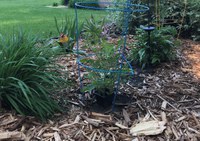Dakota Gardener: Pruning Tomatoes
(Click an image below to view a high-resolution image that can be downloaded)
By Carrie Knutson, NDSU Extension Agent, Grand Forks County
“Mistakes, I have made a few” I believe is a line from a Frank Sinatra song.
I have made many mistakes during my gardening career. I try to learn from these mistakes and not repeat them next time.
In years past, I learned, but I haven’t fixed my one of my mistakes. One mistake I make is not pruning my tomatoes. The growing season seems to go by so fast, and before I know it, my tomatoes cages are broken and plants are lying on the ground. That’s very disappointing for me, but I think the slugs look forward to the feast every year.
Pruning tomatoes doesn’t take that much time and is pretty easy to do, although a little bit of knowledge helps.
First, tomatoes have compound leaves. Each leave has five or more leaflets. A sucker may grow from the base of each leaf where it attaches to the stem of the vine.
Second, tomatoes are of two types: indeterminate and determinate. Determinate tomatoes stop growing when they reach a certain height, usually 4 to 5 feet. Indeterminate tomatoes continue to grow and produce suckers all growing season.
Popular determinate varieties include Celebrity, Defiant and Roma, and bush types such as Bush Early Girl and Bush Goliath. Popular indeterminate varieties include Big Beef, Big Boy, Early Girl and Juliet. Many heirloom and cherry tomato varieties have indeterminate vines.
To prune determinate tomatoes, locate the first sucker below the first flower cluster. You can keep this sucker and remove suckers that are below and you are done.
Indeterminate tomatoes will need a little more work. These tomatoes start the same way as determinate tomatoes, but you will need to remove all other suckers above sucker No. 1. You also can leave a few suckers to help your plant fill in and produce more fruit. This is where the art of gardening comes in - finding a pruning method that works for your needs.
If your tomatoes are still a little unruly, you can trim back the tops of the vine.
Prune tomatoes when plants are dry and the shoots are small. The suckers will be easier to remove when they are small and this will reduce the chances of damaging the plant. A scissors or pruners can be used to remove the shoots and will give you a clean cut.
Pruning will help increase air flow, reducing the chances of disease development. You also will want to remove any leaves that are touching the soil for the same reason.
I can almost taste the tomatoes and can’t wait for the first tomato to ripen. The slugs will just have to dream about them this year. Happy gardening!
For more information, contact your local NDSU Extension agent. Find the Extension office for your county at https://www.ag.ndsu.edu/extension/directory/counties.
NDSU Agriculture Communication - June 16, 2020
| Source: | Carrie Knutson, 701-780-8229, carrie.knutson@ndsu.edu |
|---|---|
| Editor: | Ellen Crawford, 701-231-5391, ellen.crawford@ndsu.edu |




